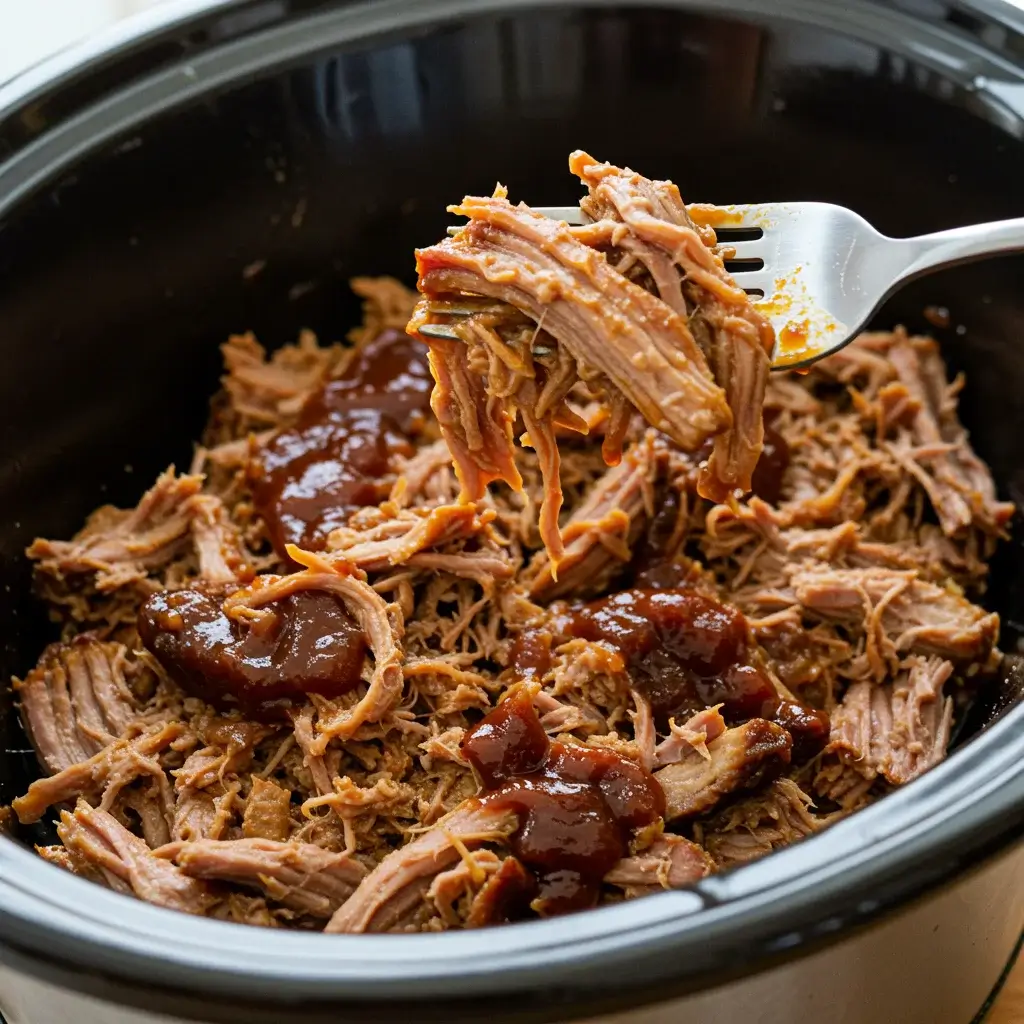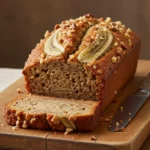Pulled pork is a classic dish cherished by many for its tender meat and savory flavor. Cooking it in a slow cooker not only simplifies the process but also enhances the flavors, making it a perfect choice for both novice and experienced cooks. This guide will walk you through everything you need to know about making delicious slow cooker pulled pork, from the ingredients and instructions to nutrition facts and serving suggestions. Let’s dive into the world of slow-cooked goodness!
Ingredients
Before you start, gather all the ingredients to ensure a smooth cooking process. Here’s what you’ll need:
- Pork Shoulder/Boston Butt (4-5 pounds)
- Onion (1 large, finely chopped)
- Garlic (4 cloves, minced)
- Paprika (2 tablespoons)
- Brown Sugar (1/4 cup)
- Cumin (1 tablespoon)
- Salt (2 teaspoons)
- Black Pepper (1 teaspoon)
- Apple Cider Vinegar (1 cup)
- Barbecue Sauce (1 cup)
- Chicken Broth (1 cup)
- Worcestershire Sauce (2 tablespoons)
These ingredients combine to create a flavorful and aromatic pulled pork that melts in your mouth.
Instructions
Follow these step-by-step instructions to create a pulled pork masterpiece that will impress your friends and family:
Preparation
- Trim the Pork: Remove excess fat from the pork shoulder, but leave some for flavor and moisture.
- Mix the Dry Rub: In a small bowl, combine paprika, brown sugar, cumin, salt, and black pepper. Mix well.
- Season the Pork: Rub the spice mixture evenly over the entire surface of the pork shoulder. Let it sit for at least 30 minutes to absorb the flavors.
Cooking
- Prepare the Slow Cooker: Place the chopped onions and minced garlic at the bottom of the slow cooker.
- Add the Pork: Place the seasoned pork shoulder on top of the onion and garlic mixture.
- Mix the Liquid Ingredients: In a separate bowl, combine apple cider vinegar, barbecue sauce, chicken broth, and Worcestershire sauce. Stir until well mixed.
- Pour the Mixture: Pour the liquid mixture over the pork in the slow cooker.
- Cook: Cover the slow cooker and set it to low heat. Cook for 8-10 hours, or until the pork is tender and easily pulls apart with a fork.
- Shred the Pork: Once cooked, remove the pork from the slow cooker and place it on a large tray. Use two forks to shred the meat into pieces.
- Mix with Juices: Return the shredded pork to the slow cooker and mix it with the remaining juices for added flavor.
Nutrition Facts
Understanding the nutritional content of your meals helps you make informed eating choices. Here’s a breakdown of the nutrition facts for a serving of slow cooker pulled pork:
- Calories: 350 per serving
- Protein: 25g
- Fat: 20g
- Saturated Fat: 7g
- Carbohydrates: 15g
- Sugars: 10g
- Fiber: 1g
- Sodium: 600mg
These values are approximate and can vary based on portion size and specific ingredients used.
How to Serve
Pulled pork is a delightful and versatile dish that can be enjoyed in a variety of ways, making it an excellent choice for any meal, whether it’s a casual weeknight dinner or a festive gathering. Below are several comprehensive serving suggestions that will inspire you to elevate your pulled pork experience.
Sandwiches
Classic Pulled Pork Sandwich
One of the most popular ways to serve pulled pork is on a toasted bun. To assemble, generously pile the tender, smoky pulled pork onto a soft, toasted hamburger bun. For an added crunch and flavor, top it with a creamy coleslaw made from shredded cabbage, carrots, and a tangy dressing that complements the rich meat. A drizzle of extra barbecue sauce on top adds moisture and enhances the savory experience. For a twist, consider using a brioche or potato bun for a slightly sweet taste that pairs well with the smoky flavors.
Sliders
Pulled pork sliders are an excellent option for parties or gatherings, allowing guests to enjoy small bites without committing to a full sandwich. Use mini buns or dinner rolls to create bite-sized morsels. You can customize each slider by offering a variety of toppings such as pickled jalapeños, fried onions, or gourmet cheeses like smoked gouda. To make it more interactive, set up a slider bar where guests can build their own, choosing from different sauces—like mustard-based, vinegar-based, or even spicy chipotle sauces—adding a fun and personalized touch to your spread.
Tacos
Pulled Pork Tacos
Transform your pulled pork into a flavorful taco filling by placing it in soft corn or flour tortillas, or even crispy taco shells. For a delicious topping, add fresh avocado slices or guacamole, which provide creaminess that balances the meat’s richness. Sprinkle with chopped cilantro for a burst of freshness and a squeeze of lime juice to enhance the flavors. For an extra kick, consider adding pickled red onions or jalapeños. You can also create a taco bar where guests can customize their tacos with a variety of toppings, such as salsa verde, pico de gallo, or shredded cheese.
Salads
Pulled Pork Salad
For a lighter option, incorporate pulled pork into a fresh salad. Start with a base of mixed greens or arugula, then layer in ingredients such as cherry tomatoes, crisp cucumbers, and shredded carrots. The pulled pork adds protein and a smoky flavor that contrasts beautifully with the fresh vegetables. Drizzle with your choice of dressing—ranch, vinaigrette, or a zesty barbecue dressing—to tie the flavors together. For additional texture, consider adding nuts, seeds, or crispy tortilla strips, and even fruits like apple slices or mandarin oranges for a sweet element that complements the savory pork.
Bowls
Pulled Pork Bowl
Create a hearty pulled pork bowl by combining the meat with a base of rice—white, brown, or even cauliflower rice for a low-carb option. Add black beans for protein and fiber, corn for sweetness, and diced tomatoes for acidity. To enhance the bowl, include toppings such as avocado, shredded cheese, jalapeños, and fresh cilantro. Drizzle with barbecue sauce or a creamy dressing, like chipotle ranch, for added flavor. This customizable approach allows everyone to personalize their bowl according to their preferences, making it a crowd-pleaser for any occasion.
These serving suggestions not only highlight the versatility of pulled pork but also provide various ways to enjoy this beloved dish. Whether you’re hosting a casual gathering or looking for a quick weeknight dinner, these ideas will ensure that your pulled pork is the star of the meal. Feel free to mix and match these serving styles and toppings to create a unique experience that suits your taste and occasion!
Additional Tips
To ensure your pulled pork is nothing short of spectacular, consider these additional tips that will elevate your dish and enhance the overall flavor and texture:
Searing the Pork
One of the simplest yet most effective techniques to amplify the flavor of your pulled pork is to sear the pork shoulder before cooking it in the slow cooker. This step involves heating a skillet over medium-high heat, adding a bit of oil, and then placing the pork in the hot skillet. Sear each side for about 3-4 minutes until a rich, golden-brown crust forms. This process not only locks in the natural juices but also creates a depth of flavor through the Maillard reaction, which adds a savory complexity to the final dish. After searing, transfer the pork shoulder to the slow cooker and proceed with your preferred seasoning and cooking method.
Adjusting Spice Levels
Every palate is different, and you have the freedom to tailor the spice levels in your pulled pork to suit your preferences. If you enjoy a bit more heat, consider adding extra smoked paprika, cayenne pepper, or even chili powder to the spice rub. Conversely, if you prefer a milder flavor, you can reduce the amounts of these spices or incorporate sweeter elements like brown sugar or honey to balance the heat. A great way to gauge your spice preferences is to taste the seasoning mix before applying it to the meat; this will help you adjust the flavors according to your liking.
Storing Leftovers
Pulled pork is not only a delicious meal but also a versatile leftover that can be enjoyed in various ways. To ensure the quality and safety of your leftovers, store them in an airtight container in the refrigerator for up to three days. Make sure to allow the pork to cool to room temperature before sealing it to avoid condensation, which can lead to spoilage. For longer storage, freezing is an excellent option; simply transfer the pulled pork to a freezer-safe bag or container, removing as much air as possible to prevent freezer burn. Properly stored, your pulled pork can remain fresh and flavorful for up to three months. Label the containers with the date to keep track of their freshness.
Reheating Tips
Reheating pulled pork can be a delicate process, as you want to preserve its tenderness and moisture. To achieve the best results, place the pork in a saucepan over low to medium heat. Add a splash of the cooking liquid or some barbecue sauce to the pan; this will infuse moisture back into the meat and prevent it from drying out. Stir occasionally, allowing the pork to heat evenly without cooking it further. If you prefer, you can also reheat pulled pork in the microwave; just be sure to cover it with a damp paper towel to retain moisture. For an even more flavorful experience, consider reheating the pulled pork in a slow cooker on low for a couple of hours, which allows the flavors to meld beautifully while keeping the meat tender.
Incorporating these tips into your pulled pork preparation will not only help you achieve delicious results but also ensure that your dish remains enjoyable even after the initial cooking. Whether you are serving it at a gathering or savoring it as leftovers, these enhancements can make all the difference in your culinary experience.
FAQs
Can I use a different cut of pork? Yes, you can indeed use different cuts of pork for making pulled pork, but it’s essential to understand how the choice of meat affects the final dish. Pork loin and pork tenderloin are leaner options that can be used, but they may not yield the same level of tenderness and flavor that you would get from a fattier cut. Pork loin can dry out more easily during the cooking process due to its lower fat content, while pork tenderloin, although tender, may lack the robust flavor profile associated with traditional pulled pork. The ideal cuts for pulled pork are pork shoulder (also known as pork butt) and Boston butt. These cuts are known for their generous marbling, which consists of intramuscular fat that melts during the slow cooking process. This fat not only keeps the meat moist but also enhances its flavor, resulting in a richer and more satisfying dish. If you’re looking for an alternative, you might also consider using pork belly, which is even fattier and will yield a decadent pulled pork with an incredibly tender texture.
Can I cook pulled pork on high heat? Cooking pulled pork on low heat is the traditional method that allows the connective tissues in the meat to break down over an extended period, resulting in a tender texture and deep flavor. Typically, this low-and-slow technique involves cooking the pork at temperatures between 225°F to 275°F for 8 to 12 hours, depending on the size of the cut. However, if you’re short on time, you can opt for cooking on high heat. This method typically involves cooking the pork at temperatures around 325°F to 350°F for about 4 to 5 hours. While this will yield a quicker meal, it’s crucial to be aware that the texture and flavor may not be as ideal. The high heat can lead to a drier texture and may not allow enough time for the connective tissues to fully break down, which is essential for achieving that melt-in-your-mouth quality that pulled pork is known for. If using this method, consider wrapping the pork in foil during the cooking process to help retain moisture.
How do I make the pulled pork spicy? If you’re looking to add some heat to your pulled pork, there are several effective ways to do so. One of the simplest methods is to incorporate cayenne pepper or red pepper flakes into your dry rub. Adjust the amount based on your heat preference; starting with a teaspoon and increasing as desired can help you achieve the right level of spice without overwhelming the dish. Additionally, you can enhance the flavor by adding hot sauce to your liquid mixture, whether it’s a vinegar-based sauce, a barbecue sauce, or even a broth. Consider using a spicy barbecue sauce or a homemade version that includes ingredients like chipotle peppers or jalapeños for a smoky, spicy kick. For those who enjoy experimenting, adding fresh sliced jalapeños or serrano peppers into the cooking liquid can infuse the pork with heat and flavor. Another technique is to serve the pulled pork with a spicy vinegar sauce or a hot pepper sauce on the side, allowing guests to customize their heat level.
What sides pair well with pulled pork? Pulled pork is a versatile dish that pairs beautifully with a variety of sides, enhancing the overall meal experience. Classic accompaniments include coleslaw, which provides a crunchy and refreshing contrast to the rich meat, and baked beans, which add a sweet and hearty element to the plate. Cornbread is another traditional favorite, offering a slightly sweet and buttery complement to the savory pork. For those who enjoy potato dishes, potato salad is a popular choice, especially during summer barbecues, as its creamy texture contrasts well with the pulled pork. Mac ‘n cheese is also a fan favorite, providing a comforting and indulgent side that pairs well with the smoky flavors of the meat. Other sides to consider include grilled vegetables, pickles, or even a fresh garden salad to balance the richness of the pulled pork. If you’re hosting a gathering, consider creating a buffet-style setup where guests can mix and match their preferred sides with the pulled pork.
Can I make pulled pork in advance? Absolutely! Making pulled pork in advance is not only feasible but often recommended for optimal flavor. When prepared a day ahead, the flavors have time to meld and develop, resulting in a more nuanced and delicious dish. To store, allow the pulled pork to cool completely, then place it in an airtight container in the refrigerator. When you’re ready to serve, simply reheat the pork gently, either on the stovetop, in the oven, or in a slow cooker. If reheating in the oven, cover the dish with aluminum foil to retain moisture and heat at a low temperature. You might want to add a splash of broth or barbecue sauce to keep the meat from drying out during reheating. For larger gatherings, consider pulling the pork and mixing it with sauce before refrigerating, so it’s ready to serve directly from the container, making your meal preparation even easier. Additionally, leftover pulled pork can be frozen for future use, extending its shelf life and providing a convenient meal option down the line.
Conclusion
Slow cooker pulled pork is a delightful dish that’s easy to prepare and incredibly versatile. Whether you’re hosting a barbecue, planning a family dinner, or simply craving comfort food, this recipe is sure to satisfy. By following these instructions, tips, and serving suggestions, you’ll create a mouthwatering meal that will have everyone asking for seconds. Enjoy the succulent flavors and tender texture of homemade pulled pork!
Print
Slow Cooker Pulled Pork Recipe
Ingredients
- Pork Shoulder/Boston Butt (4-5 pounds)
- Onion (1 large, finely chopped)
- Garlic (4 cloves, minced)
- Paprika (2 tablespoons)
- Brown Sugar (1/4 cup)
- Cumin (1 tablespoon)
- Salt (2 teaspoons)
- Black Pepper (1 teaspoon)
- Apple Cider Vinegar (1 cup)
- Barbecue Sauce (1 cup)
- Chicken Broth (1 cup)
- Worcestershire Sauce (2 tablespoons)
Instructions
Preparation
- Trim the Pork: Remove excess fat from the pork shoulder, but leave some for flavor and moisture.
- Mix the Dry Rub: In a small bowl, combine paprika, brown sugar, cumin, salt, and black pepper. Mix well.
- Season the Pork: Rub the spice mixture evenly over the entire surface of the pork shoulder. Let it sit for at least 30 minutes to absorb the flavors.
Cooking
- Prepare the Slow Cooker: Place the chopped onions and minced garlic at the bottom of the slow cooker.
- Add the Pork: Place the seasoned pork shoulder on top of the onion and garlic mixture.
- Mix the Liquid Ingredients: In a separate bowl, combine apple cider vinegar, barbecue sauce, chicken broth, and Worcestershire sauce. Stir until well mixed.
- Pour the Mixture: Pour the liquid mixture over the pork in the slow cooker.
- Cook: Cover the slow cooker and set it to low heat. Cook for 8-10 hours, or until the pork is tender and easily pulls apart with a fork.
- Shred the Pork: Once cooked, remove the pork from the slow cooker and place it on a large tray. Use two forks to shred the meat into pieces.
- Mix with Juices: Return the shredded pork to the slow cooker and mix it with the remaining juices for added flavor.
Nutrition
- Serving Size: one normal portion
- Calories: 350 per serving
- Sugar: 10g
- Sodium: 600mg
- Fat: 20g
- Saturated Fat: 7g
- Carbohydrates: 15g
- Fiber: 1g
- Protein: 25g





